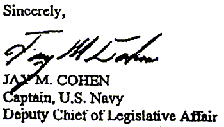Arsenal Ship Lessons Learned Report
TAB I
OFFICE OF LEGISLATIVE AFFAIRS
1300 NAVY, PENTAGON
LA-2:bj
October 24, 1997
MEMORANDUM FOR INTERESTED MEMBERS OF CONGRESS
Subj:MARITIME FIRE SUPPORT DEMONSTRATOR (MFSD)
1. Appreciating your interest in the current plans, policies, and programs of the Department of the Navy, please be advised that after reviewing Navy budget priorities, Secretary of the Navy John H. Dalton has reluctantly determined that insufficient funding exists to continue the next phase of the Maritime Fire Support Demonstrator (MFSD) program. The $35 million appropriated by Congress is not enough to enter the next phase of the MFSD development plan, which would include the award of a detailed design and construction contract in 1998. The Navy has reviewed and prioritized its programs and has determined that it is not possible to redistribute money from other areas to sustain the MFSD program. Reallocation of the $35 million appropriated by Congress is currently under review by the Navy.
2. The initial phases of the MFSD program provided a good return for the investment. these phases were highly successful in forming closer partnerships with industry as demonstrated by the teaming of combat system integrators and shipyards. the Navy is 100 percent committed to the fleet modernization that the MFSD program represented: teaming produced innovative concepts for modular integration of combat systems, improved ship survivability, design, radar signature reduction techniques, and reduced manning requirements. These innovations are directly transferable tot he Land Attack Destroyer (DD21). With the cancellation of the MFSD program, the Navy will lose the opportunity and the advantages of integrating these technologies into a single test platform at sea.
3. DD 21 development will continue as planned, using an acquisition strategy patterned after the MFSD. The program turns the systems development process over to industry teams at the earliest stage and challenges industry to develop and design the optimum mix of performance capabilities which can be accommodated within production and life-cycle affordability constraints. This approach has already produced several technological breakthroughs in the initial stage of MFSD development, and the Navy is confident that industry will deliver a revolutionary ship in DD 21.
4. Planned milestones for the DD 21 program include: December 1997 - Initiate Request for Proposals; March 1998 - Award multiple concept development contracts; 2004 - Award contract for the first DD 21.
5. The Office of Legislative Affairs point of contact is Commander Pete Gumataotao, USN, at (703) 695-1366.
![]()

October 24, 1997 1600
Maritime Fire Support Demonstrator
After reviewing Navy budge priorities, Secretary of the Navy John H. Dalton has reluctantly determined that insufficient funding exists to continue the next phase of the MFSD program. The Navy and DARPA jointly requested $150 million in FY 1998 for the MFSD program. The $35 million appropriated by Congress is not enough to enter the next phase of the MFSD development plan, which would include the award of a detailed design and construction contract in 1998. The Navy has reviewed and prioritized its programs and has determined that it is not possible to redistribute money from other areas to sustain the MFSD program. Reallocation of the $35 million appropriated by Congress is currently under review by the Navy.
The initial phases of the MFSD program provided a good return for the investment. These phases were highly successful in forming closer partnerships with industry as demonstrated by the teaming of combat system integrators and shipyards. The Navy is 100 percent committed to the fleet modernization that the MFSD program represented: teaming produced innovative concepts for modular integration of combat systems, improved ship survivability design, radar signature reduction techniques, and reduced manning requirements. these innovations are directly transferable to the Land Attack Destroyer (DD 21). With the cancellation of the MFSD program, the Navy will lose the opportunity and the advantages of integrating these technologies into a single test platform at sea.
DD 21 development will continue as planned, using an acquisition strategy patterned after MFSD. The program turns the systems development process over to industry teams at the earliest stage and challenges industry to develop and design the optimum mix of performance capabilities which can be accommodated within production and life-cycle affordability constraints. This approach has already produced several technological breakthroughs in the initial stage of MFSD development, and the Navy is confident that industry will deliver a revolutionary ship in DD 21.
-
Planned milestones for the DD 21 program include:
December 1997 - Initiate Request For Proposals
March 1998 - Award multiple concept development contracts
2004-Award contract for the first DD 21.